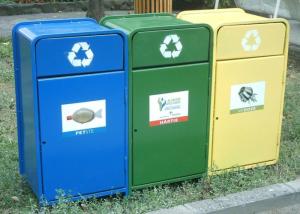- 49 reads

Everybody wants to recycle. The benefits are documented and numerous. Everybody says that they recycle. But studies have shown that more people are taking claim for this practice than are actually doing it. In the United States alone, only 50 percent of households participate in a recycling program. This lack of participation has threatened or actually caused municipal recycling programs and facilities to end or close.
Why don't people want to recycle? They offer three primary excuses:
- they're not sure what can be recycled
- it's too time-consuming to separate items
- it's too inconvenient to drop off items to be recycled
Communities in Ohio and North Carolina are trying innovative "carrot and stick" programs to get neighborhoods to comply with recycling programs. But experts say that the most effective recycling approaches that are ones that make recycling as ingrained as simply taking trash cans to the curb. Such an approach takes practice, and it's not without backsliding. But as the saying goes, "practice makes perfect". With that in mind, below are some practical tips for perfecting your recycling techniques.
1. Set Up A Bin System
A recycling bin isn't the same thing as a general trash can. And yet, when recycling bins get set out in the house, that's often what they end up becoming. It's not just enough to place bins in a household and give them certain designations. In order to ensure that recycling bins are used and used properly:
- clearly, mark bins with writing and pictures
- fit bin lids to only accept certain kinds of recyclables, such as slot lids for paper and small openings for bottles and cans
- put bins in close proximity to "waste streams"
2. Get The Kids Involved
Given what they've been learning and experimenting with in school, your children are probably already the family recycling experts. Take advantage of that knowledge by having school age children collect safe recyclables, put them in the proper bins, and monitor them to be sure they're being used properly. Smaller children enjoy the "game" of helping older household members separate recyclable items and putting them in their proper places. And point out to children that the money returned to the household from successful recycling can be used for things important to them like movies, trips to the zoo, and ice cream!
3. Recycle Your Water
Yes, water already recycles itself. But we can prevent waste and pollution of this ancient system by doing some recycling here, too. Don't just cut back on shower and dishwashing time. Reuse "gray" water from baths, laundry, and dishes to flush toilet bowls. Use cool pans of plain cooking water to give plants a drink. And planting "rain gardens" in the back yard not only saves on your water bills, it helps to reduce potentially dangerous storm runoff.
4. Recycle Your Greenery
Lawn clippings and tree leaves and branches are major landfill cloggers. If you don't want to make your own mulch and compost, your community may have a program that does so. Just remember to avoid chemical contamination by setting this greenery out for collection in 35 or 40-gallon plastic barrels as opposed to plastic trash bags. Many communities will pick up trees and other holiday greenery for recycling with regular trash. And Christmas trees are increasingly being used for wildlife and fish habitats, as well as erosion prevention. A few phone calls can help you find a new life for your old tree.
5. Recycle Your Plastic
Not all plastic is easily sorted by code for disposal. Printer cartridges, in particular, have presented challenges. Many printer cartridge manufacturers now offer mail back options for cartridges at no cost to users. There are very few plastics that can't be recycled these days. Contacting your municipal office with questions can help start this process quickly and effectively.
6. Be A Waste Stream Analyst
Effective home recycling begins by being able to track how recyclable items are moving through and out of your home. By effectively tracking your recyclable item stream, you can make sure that recyclable items are actually getting recycled. Track the stream by:
- correctly identifying recyclable items
- have distinct home collection sites for them
- keep paperwork concerning pickup and drop off of such items
And in addition to recycling, households should be thinking about making lifestyle choices and changes that reduce the need to recycle as much as possible. Lessening our planetary footprints in this way sets us on a path to green living that not just reduces waste and costs, but truly preserves our planet.

